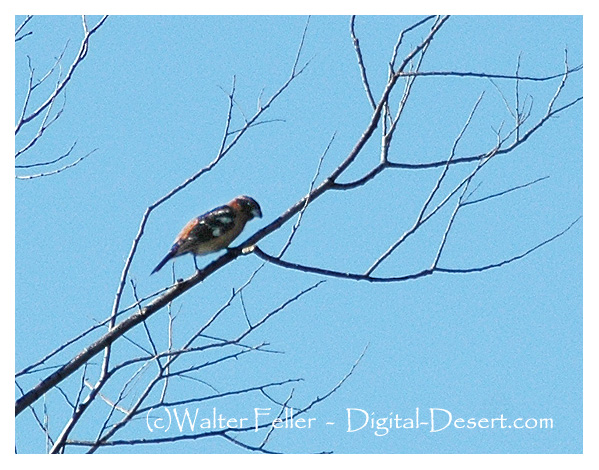Black-headed Grosbeak
Pheucticus melanocephalus
Family: CARDINALIDAE
Order: PASSERIFORMES
Class: AVES
DISTRIBUTION, ABUNDANCE, AND SEASONALITY
A common summer resident and transient. From April into September, a common breeder throughout most of California, excluding higher mountains, Great Basin, and southern deserts. Frequents valley foothill hardwood, valley foothill hardwood-conifer, valley foothill riparian, and montane riparian habitats. Less common in other wooded habitats of lower montane elevations, often near water and areas where deciduous oaks are numerous. Also breeds in pinyon-juniper habitat in several desert mountain ranges from Mono Co. to San Bernardino Co. A rare and local breeder in lowlands east of the Cascade Sierra Nevada crest. Occurs more widely in migration; e.g., in southern deserts. Rare and irregular in California from October to late March (Grinnell and Miller 1944, McCaskie et al. 1979, Garrett and Dunn 1981).
SPECIFIC HABITAT REQUIREMENTS
Feeding: While nesting, feeds primarily on insects and spiders (Martin et al. 1961, Bent 1968, Airola 1979); also eats buds, berries and other fruits, and seeds. More plant foods often taken after breeding and in migration. Plucks fruits and buds from shrubs and trees. Gleans insects from foliage, especially in deciduous trees; occasionally hawks in air. Regularly feeds on ground; will take scraps in campgrounds and picnic areas.
Cover: Requires trees and shrubs for nesting, roosting, and other cover.
Reproduction: Builds nest in a shrub or tree, often beside stream or other water, but may be located away from water in open woodland, orchard, or near edge of denser woodland. Height of 163 nests in California varied from 0.9 to 7.5 m (3-25 ft), but most were between 1.8 and 3.6 m (6 and 12 ft) above ground (Weston 1947).
Water: Drank water frequently in an oak woodland in coastal range (Williams and Koenig 1980); water probably required.
Pattern: Occurs in open woodlands and near edges of denser stands; favors habitats with deciduous trees, especially oaks, and a diversity of plant life.
SPECIES LIFE HISTORY
Activity Patterns: Yearlong, diurnal activity.
Seasonal Movements/Migration: California breeding population migrates to wintering grounds in Mexico; mostly departs in August and September and returns from late March into May.
Home Range: No information found. In riparian forests of Sacramento Valley, Gaines (1974a) recorded 31-66 singing males per 40 ha (100 ac), perhaps the highest reported breeding density.
Territory: Weston (1947) noted that female may be territorial, but male tends to defend female rather than territory.
Reproduction: Breeding season late April into August. A monogamous, solitary nester. Clutch size 2-5, usually 3 or 4, and a single brood per yr. Incubation 12-13 days by both sexes. Altricial young tended by both parents and leave nest at 11-12 days. Fledglings may stay with female for a long period (Weston 1947). Probably breeds first at 1 yr (Harrison 1978).
Niche: Apparently an uncommon cowbird host (Ehrlich et al. 1988). Both sexes may sing on nest.
REFERENCES
Airola, D. A. 1979. Foraging and habitat relations of insectivorous birds in a managed Sierra Nevada mixed conifer forest. M.S. Thesis, Univ. Califoria, Berkeley. 59pp.
Bent, A. C. (O. L. Austin, Jr., ed.). 1968. Life histories of North American cardinals, grosbeaks, buntings, towhees, finches, sparrows, and allies. 3 Parts. U.S. Natl. Mus. Bull. 237. 1889pp.
Ehrlich, P. R., D. S. Dobkin, and D. Wheye. 1988. The birder's handbook. Simon and Schuster, New York. 785pp.
Gaines, D. 1974a. A new look at the nesting riparian avifauna of the Sacramento Valley, California. West. Birds 5:61-80.
Garrett, K., and J. Dunn. 1981. Birds of southern California. Los Angeles Audubon Soc. 408pp.
Grinnell, J., and A. H. Miller. 1944. The distribution of the birds of California. Pac. Coast Avifauna No. 27. 608pp.
Harrison, C. 1978. A field guide to the nests, eggs and nestlings of North American birds.
W. Collins Sons and Co., Cleveland, OH. 416pp. Martin, A. C., H. S. Zim, and A. L. Nelson. 1961. American wildlife and plants, a guide to wildlife food habits. Dover Publ., Inc., New York. 500pp. McCaskie, G., P. De Benedictis, R. Erickson, and J. Morlan. 1979. Birds of Northern California, an annotated field list. 2nd ed. Golden Gate Audubon Soc., Berkeley. 84pp.
Weston, H. G., Jr. 1947. Breeding behavior of the black-headed grosbeak. Condor 49:54-73.
Williams, P. L., and W. D. Koenig. 1980. Water dependence of birds in a temperate oak woodland. Auk 97:339-350.
Life history accounts for species in the California Wildlife Habitat Relationships (CWHR) System were originally published in: Zeiner, D.C., W.F.Laudenslayer, Jr., K.E. Mayer, and M. White, eds. 1988-1990. California's Wildlife. Vol. I-III. California Depart. of Fish and Game, Sacramento, California. Updates are noted in accounts that have been added or edited since original publication.
Written by: S. Granholm
Reviewed by: L. Mewaldt
Edited by: R. Duke
Pheucticus melanocephalus
A medium-size seed-eating bird, 21cm long, 47 g weight. Black-headed Grosbeak is a migratory bird, with nesting grounds from southwestern British Columbia, through the western half of the United States, into central Mexico. Common in open woodlands and forest edges.
300-birds